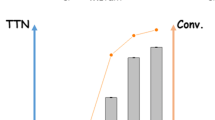Abstract
Chiral alcohols are valuable as diverse chemicals and synthetic intermediate materials. Phenylacetaldehyde reductase (PAR) is an enzyme that converts a wide variety of ketones into chiral alcohols with high optical purity. When an alcohol such as 2-propanol is used as a hydrogen donor, PAR itself will also mediate the regeneration of the coenzyme NADH in situ. Perceiving a capacity for improvement, we sought to develop a PAR that is able to convert higher concentrations of substrates in the presence of high concentrations of 2-propanol. The selection procedure for mutants was re-examined and a procedure able to select an effective amino acid substitution was established. Two advantageous amino acid substitutions were successfully selected using the procedure. When high-concentration substrate conversion reaction was subjected with a mutant that integrated both the two amino acid substitutions, near-complete conversions of m-chlorophenacyl chloride (m-CPC) (2.1 mmol/ml) and ethyl 4-chloro-3-oxobutanoate (ECOB) (1.9 mmol/ml) were achieved.




Similar content being viewed by others
References
De Wildeman SM, Sonke T, Schoemaker HE, May O (2007) Biocatalytic reductions: from lab curiosity to “first choice”. Acc Chem Res 40:1260–1266
Goldberg K, Schroer K, Lütz S, Liese A (2007a) Biocatalytic ketone reduction—a powerful tool for the production of chiral alcohols—part I: processes with isolated enzymes. Appl Microbiol Biotechnol 76:237–248
Goldberg K, Schroer K, Lütz S, Liese A (2007b) Biocatalytic ketone reduction—a powerful tool for the production of chiral alcohols—part II: whole-cell reductions. Appl Microbiol Biotechnol 76:249–255
Itoh N, Isotani K, Nakamura M, Inoue K, Isogai Y, Makino Y (2012) Efficient synthesis of optically pure alcohols by asymmetric hydrogen-transfer biocatalysis: application of engineered enzymes in a 2-propanol-water medium. Appl Microbiol Biotechnol 93:1075–1085. doi:10.1007/s00253-011-3447-4
Itoh N, Matsuda M, Mabuchi M, Dairi T, Wang J (2002) Chiral alcohol production by NADH-dependent phenylacetaldehyde reductase coupled with in situ regeneration of NADH. Eur J Biochem 269:2394–2402
Itoh N, Morihama R, Wang J, Okada K, Mizuguchi N (1997) Purification and characterization of phenylacetaldehyde reductase from a styrene-assimilating Corynebacterium strain, ST-10. Appl Environ Microbiol 63:3783–3788
Itoh N, Nakamura M, Inoue K, Makino Y (2007) Continuous production of chiral 1,3-butanediol using immobilized biocatalysts in a packed bed reactor: promising biocatalysis method with an asymmetric hydrogen-transfer bioreduction. Appl Microbiol Biotechnol 75:1249–1256
Kataoka M, Yamamoto K, Kawabata H, Wada M, Kita K, Yanase H, Shimizu S (1999) Stereoselective reduction of ethyl 4-chloro-3-oxobutanoate by Escherichia coli transformant cells coexpressing the aldehyde reductase and glucose dehydrogenase genes. Appl Microbiol Biotechnol 51:486–490
Kroutil W, Mang H, Edegger K, Faber K (2004) Recent advances in the biocatalytic reduction of ketones and oxidation of sec-alcohols. Curr Opin Chem Biol 8:120–126
Makino Y, Dairi T, Itoh N (2007) Engineering the phenylacetaldehyde reductase mutant for improved substrate conversion in the presence of concentrated 2-propanol. Appl Microbiol Biotechnol 77:833–843
Makino Y, Inoue K, Dairi T, Itoh N (2005) Engineering of phenylacetaldehyde reductase for efficient substrate conversion in concentrated 2-propanol. Appl Environ Microbiol 71:4713–4720
Matsuda T, Yamanaka T, Nakamura K (2009) Recent progress in biocatalysis for asymmetric oxidation and reduction. Tetrahedron Asymmetry 20:513–557
Moore JC, Pollard DJ, Kosjek B, Devine PN (2007) Advances in the enzymatic reduction of ketones. Acc Chem Res 40:1412–1419
Ni Y, Xu JH (2012) Biocatalytic ketone reduction: a green and efficient access to enantiopure alcohols. Biotechnol Adv 30:1279–1288. doi:10.1016/j.biotechadv.2011.10.007
Sambrook J, Fritsch EF, Maniatis T (1989) Molecular cloning—a laboratory manual, 2nd edn. Cold Spring Harbor Laboratory Press, Cold Spring Harbor
Tseng WC, Lin JW, Wei TY, Fang TY (2008) A novel megaprimed and ligase-free, PCR-based, site-directed mutagenesis method. Anal Biochem 375:376–378. doi:10.1016/j.ab.2007.12.013
Wang JC, Sakakibara M, Liu JQ, Dairi T, Itoh N (1999) Cloning, sequence analysis, and expression in Escherichia coli of the gene encoding phenylacetaldehyde reductase from styrene-assimilating Corynebacterium sp. strain ST-10. Appl Microbiol Biotechnol 52:386–392
Acknowledgments
We thank Sumitomo Chemical for the supply of m-CPC.
Conflict of interest
The authors declare that they have no conflict of interest.
Author information
Authors and Affiliations
Corresponding author
Rights and permissions
About this article
Cite this article
Makino, Y., Itoh, N. Development of an improved phenylacetaldehyde reductase mutant by an efficient selection procedure. Appl Microbiol Biotechnol 98, 4437–4443 (2014). https://doi.org/10.1007/s00253-013-5406-8
Received:
Revised:
Accepted:
Published:
Issue Date:
DOI: https://doi.org/10.1007/s00253-013-5406-8




